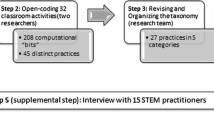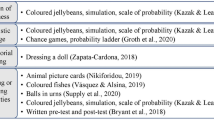Abstract
In this study, we investigated the impact of computer spreadsheets on the problem solving practices of students for math story problems, and more specifically on the transition from arithmetic to algebraic reasoning, through the construction of algebraic expressions. We investigated the relationships among the students’ prior knowledge and skills, the verification processes, and the effectiveness of the problem solving tasks. For identifying the factors involved in the problem solving process and their role, in our analysis we employed the Structural Equation Modeling (SEM) approach. We mainly focused on math story problems and on students of tertiary education with little prior experience on the use of computers and spreadsheets. Analysis of the data indicates that spreadsheets can support the transition from arithmetic to algebraic reasoning and this transition is influenced by prior skills of the students relevant to the interaction with the interface (enter formula skills), and the students’ frequency of verification of the solution.




Similar content being viewed by others
References
Abramovich, S. (2003). Spreadsheet-Enhanced Problem Solving in Context as Modeling, Spreadsheets in Education (eJSiE), Volume 1, Issue 1 2003 Article 1.
Arbuckle, J. (2007). Amos 16.0 user’s guide. Chicago: SPSS.
Beaman, I., Waldmann, E., & Krueger, P. (2005). The impact of training in financial modelling principles on the incidence of spreadsheet errors. Accounting Education, 14, 199–212.
Bolstad, W. M. (2004). Introduction to Bayesian statistics. Hoboken: Wiley.
Bostrom, R.P., Olfman, L., and Sein, M.K. (1988). The Importance of Individual Differences in End-User Training: The Case for Learning Style, in Awad E.M. (Ed), Proceedings of the 1988 ACM SIGCPR Conference, Maryland, April, pp. 133–141
Blondel, F.-M., Bruillard, E., & Tort, F. (2008). Overview and main results of the DidaTab project. In D. Ward (Ed.), In pursuit of spreadsheet excellence, proceedings of European spreadsheet risks interest group 2008 annual conference (pp. 187–198).
Branca, N. (1980). Problem solving as a goal, process and basic skill. In S. Krulik & R. Reys (Eds.), Problem solving in school mathematics 1980 yearbook (pp. 3–8). Reston: NCTM.
Cai, J. (1994). A protocol-analytis study of metacognition in mathematical problem solving. Mathematics Education Research Journal, 6, 166–183.
Cai, J., Mamona-Down, J., & Weber, K. (2005). Mathematical problem solving: what we know and where we are going. The Journal of Mathematical Behavior, 24, 217–220.
Depover, C., Karsenti, T., & Komis, V. (2007). Enseigner avec les technologies: favoriser les apprentissages, développer des compétences, 978-2-7605-1489-8. Sainte-Foy: Presses de l’Université du Québec.
Eizenberg, Μ. Μ., & Zaslavsky, O. (2004). Students’ verification strategies for combinatorial problems. Mathematical Thinking and Learning, 6(1), 15–36.
Friedlander, A. (1998). An EXCELlent bridge to algebra. Mathematics Teacher, 91(50), 382–383.
Funke, J., & Frensch, P. (1995). Complex problem solving research in North America and Europe: and integrative review. Foreign Psychology, 5, 42–47.
Galbraith, P., & Stillman, G. (2006). A framework for identifying student blockages during transitions in the modeling process. Zentralblatt für Didaktik der Mathematik, 38(2), 143–162.
Galletta, F., Hartzel, K., Johnson, S., Joseph, J., & Rustagi, S. (1997). Spreadsheet presentation and error detection: an experimental study. Journal of Management Information Systems, 13(3), 45–63.
Hershkowitz. R., & Kieran. C. (2001). Algorithmic and meaningful ways of joining together representatives within the same mathematical activity: An experience with graphing calculators. In M. van den Heuvel-Panhuizen (Ed.), Proceedings of the 25 International Conference for the Psychology of Mathematics Education (Vol. 1, pp. 96–107). Utrecht, the Netherlands: Program Committee
Johnston-Wilder, S., Pimm, D., Adams, A., and Brindley, S. (2005). Teaching Secondary Mathematics with ICT (p. 0). Open University Press.
Jonassen, D. (1996). Computers in the classroom: mindtools for critical thinking. Columbus: Merrill/Prentice-Hall.
Jonassen, D. (2000). Toward a design theory of problem solving. Educational Technology Research and Development, 48, 63–85.
Jonassen, D. (2004). Learning to solve story problems. San Francisco: Wiley.
Jonassen, D., Howland, J., Moore, J., & Marra, R. (2003). Learning to solve problems with technology: a constructivist perspective (2nd ed.). Columbus: Merrill/Prentice-Hall.
Kapa, E. (2002). A Metacognitive Support During the Process of Problem Solving in a Computerized Environment. Educational Studies in Mathematics, 317–336.
Kieran, C. (2004). The core of algebra: reflections on its main activities. In K. Stacey, H. Chick, & M. Kendal (Eds.), The future of the teaching and learning of algebra: the 12th ICMI study (pp. 21–33). Boston: Kluwer.
Kieran, C., & Chalouh, L. (1993). Prealgebra: the transition from arithmetic to algebra. In D. T. Owens (Ed.), Research ideas for the classroom: middle grades mathematics. Reston: NCTM.
Kline, R. B. (2010). Principles and practice of structural equation modeling (3rd ed.). New York: Guilford Press.
Komis, V., Lavidas, K., Papageorgiou, V., Zacharos, K., & Politis, P. (2006). L’enseignement des tableurs dans le collège grec: étude des cas et implications pour une approche interdisciplinaire. In L.-O. Pochon, E. Bruillard, & A. Marechal (Eds.), Apprendre (avec) les progiciels. Entre apprentissages scolaires et pratiques professionnelles (pp. 253–260). Neuchâtel: IRDP.
Lins, R., & Kaput, J. (2004). The early development of algebraic reasoning: the current state of the field. In K. Stacey, H. Chick, & K. Margaret (Eds.), The future of the teaching and learning of algebra the 12th ICMI study London Kluwer (pp. 45–70).
Lavidas, K., Komis, V., Zacharos, K., Papageorgiou, V. (2007). Etude de la contribution des tableurs dans le processus de résolution des problèmes en mathématiques. Scholé, vol. Hors Série 1, pp. 53–65.
Mayer, R. (1992). Thinking, problem solving, cognition. New York: W.H. Freeman and Company.
Mevarech, Ζ., & Kapa, Ε. (1996). The effects of a problem solving based logo environment on children’s information processing components. British Journal of Educational Psychology, 66, 181–195.
Muir, Τ., Beswick, Κ., & Williamson, J. (2008). I’m not very good at solving problems: an exploration of students. The Journal of Mathematical Behavior, 27, 228–241.
Nunokawa, K. (2005). Mathematical problem solving and learning mathematics: what we expect students to obtain. The Journal of Mathematical Behavior, 24, 325–340.
Palaigeorgiou, G., Siozos, P., & Konstantakis, N. (2006). CEAF: a measure for deconstructing students’ prior computer experience. Journal of Information Systems Education, 17(4), 459–468. Association of Information Technology Professionals (AITP).
Papadopoulos, I., & Dagdilelis, V. (2008). Students’ use of technological tools for verification purposes in geometry problem solving. The Journal of Mathematical Behavior, 27(4), 311–325.
Polya, G. (1957). How to solve it (2nd ed.). USA: Princeton University Press.
Powell, S. G., Baker, K. R., & Lawson, B. (2008). A critical review of the literature on spreadsheet errors. Decision Support Systems, 46(1), 128–138. doi:10.1016/j.dss.2008.06.001.
Raykov, Τ., & Marcoulides, G. A. (2006). A first course in structural equation modeling (2nd ed.). Mahwah: Erlbaum.
Schoenfeld, A. (1985). Mathematical Problem-Solving. NY: Αcademic Press.
Schoenfeld, A. (1992). Learning to think mathematically: problem solving, metacoqnition and making sense in mathematics. In D. A. Grouws (Ed.), Handbook of research on mathematics teaching and learning (pp. 334–370). New York: Macmillan.
Schwarz, B., & Dreyfus, T. (1993). Measuring integration of information in multirepresentational software. Interactive Learning Environments, 3, 177–198.
Shim, J. E., & Li, Y. (2006). Applications of Cognitive Tools in the Classroom. In M. Orey (Ed.), Emerging perspectives on learning, teaching, and technology. Retrieved 13 May 2011, from http://projects.coe.uga.edu/epltt/).
Smith, L. (2003). Internality of mental representation. Consciousness & Emotion, 4(2), 307–326.
Sutherland, R. (1993). Symbolising through spreadsheets. Micromath, 10(1), 20–22.
Sutherland, R., & Rojano, T. (1993). A spreadsheet approach to solving algebra problems. Journal of Mathematical Behaviour, 12(4), 351–383.
Sutherland, R., & Balacheff, N. (1999). Didactical complexity of computational environments for the learning of mathematics. the International Journal of Computers for Mathematical Learning, 4, 1–26.
Teo, T., & Lee-Partridge, J. (2001). Effects of error factors and prior incremental practice on spreadsheet error detection: an experimental study, Omega. International Journal of Management Science, 29, 445–456.
Tort, F. & Blondel, F.-M. (2007). Uses of spreadsheets and assessment of competencies of high school students. In: Benzie, D., Iding, M. (eds.) Proceedings of Informatics, Mathematics and ICT. IMICT 2007, College of Computer and Information Science Northeastern University, Boston, USA: College of Computer and Information Science Northeastern University. [CD-ROM]. ISBN 13: 978-0-615-14623-2.
Tort, F., Blondel, F.-M., & Bruillard, E. (2008). Spreadsheet Knowledge and Skills of French Secondary School Students. In R. T. Mittermeir & M. M. Syslo (Eds.), ISSEP 2008, LNCS 5090 (pp. 305–316). Berlin: Springer.
Tukiainen, M. (1996). ASSET: a structured spreadsheet calculation system. Machine-Mediated Learning, 5(2), 63–76.
Yerushalmy, Μ. (1991). Effects of computerized feedback on performing and debugging algebraic transformations. Journal of Educational Computing Research, 7, 309–330.
Zacharos, K., Lavidas, K., Komis, V., and Papageorgiou, V. (2007). Cognitive tools for the teaching of mathematics in High School: The case of Spreadsheets. In the 2nd Panhellenic Conference of the Association of Researchers for the Teaching of Mathematics, Alexandroupolis, 23–25 November, 468–477, Athens: Typotheto.
Acknowledgements
We would like to thank the students of the Department of Educational Sciences and Early Childhood Education of the University of Patras for their participation in this study, and the anonymous reviewers for their very constructive and insightful comments.
Author information
Authors and Affiliations
Corresponding author
Appendix
Appendix
Table of the analysis results
Rights and permissions
About this article
Cite this article
Lavidas, K., Komis, V. & Gialamas, V. Spreadsheets as cognitive tools: A study of the impact of spreadsheets on problem solving of math story problems. Educ Inf Technol 18, 113–129 (2013). https://doi.org/10.1007/s10639-011-9174-8
Published:
Issue Date:
DOI: https://doi.org/10.1007/s10639-011-9174-8




